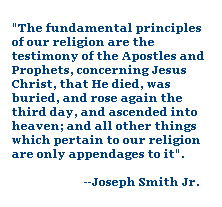Teotihaucan and the Book of Mormon
One recent archaeological opinion is that the ancient American city of Teotihuacan was a pagan and bloodthirsty civilization at the time the Book of Mormon says Jesus Christ appeared in American and the people of the land were all converted to Christianity. Some critics only superficially familiar with the Book of Mormon have been commenting how this together with genetic discoveries are somehow proof against the authenticity of the Book of Mormon.
However, I still cannot rule out Teotihuacan, "the place where men become gods," as being originally settled by the Nephites. The original builders of Teotihuacan remain a mystery, but later groups such as the Toltec's and then later the Aztecs overran the empire. The recent tomb discovery at the Temple of the Moon that is being referred to contains the remnants of human sacrifice but dates to the fifth of seven expansions of Teotihuacan. The original builders were thought to have been peaceful and worshiped Quetzalcoatl. The worship of Quetzalcoatl was known to sometimes included animal sacrifices, but Quetzalcoatl is also known to be opposed to human sacrifice (wiki). The problem with the article is the dating techniques.
In reality, mtDNA data strongly supports Book of Mormon authenticity and demonstrates that what happened at Teotihuacan is probably irrelevant to the Book of Mormon people. First, the Book of Mormon presents a clear limited geography. After the visit of Jesus Christ to His other sheep in America, the gospel of Jesus Christ spread throughout the entire land of the Book of Mormon people. This does not necessarily suggest all of North and South America.
4 Ne. 1: 2 And it came to pass in the thirty and sixth year, the people were all converted unto the Lord, upon all the face of the land (Book of Mormon Lands), both Nephites and Lamanites (No mention of other groups), and there were no contentions and disputations among them, and every man did deal justly one with another.
A series of mtDNA studies also support the authenticity of the Book of Mormon by showing that a specific mtDNA haplogroup currently found in Northern Israel and which originated in the Middle East arrived via an independent, pre-Colombian migration to the Great Lakes Region of America.
1. The Druze: A Population Genetic Refugium of the Near East. PLoS ONE. 2008 May 7;3(5)
Northern Israeli group has highest Haplogroup X concentration.
2. Origin and Diffusion of mtDNA Haplogroup X, Am J Hum Genet. 2003 November; 73(5): 1178–1190.
Haplogroup X is a founding mtDNA haplogroup in America and comes from the Middle East.
3. The Presence of Mitochondrial Haplogroup X in Altaians from South Siberia Am J Hum Genet. 2001 July; 69(1): 237–241.
Haplogroup X in America did not come from Asia, Siberia, Mongolia, or Altai Republic but came directly from the Middle East from an independent and direct migration.
4. Distribution of mtDNA haplogroup X among Native North Americans. Am J Phys Anthropol. 1999 Nov;110(3):271-84.
5. mtDNA haplogroup X: An ancient link between Europe/Western Asia and North America?Am J Hum Genet. 1998 December; 63(6): 1852–1861.
Haplogroup X is a founding mtDNA haplogroup in America and is only found in Indians around the Great Lakes region.
6. Rohde, DLT , On the common ancestors of all living humans. Submitted to American Journal of Physical Anthropology. (2005)
7. Rohde DLT, Olson S, Chang JT (2004) "Modelling the recent common ancestry of all living humans". Nature 431: 562-566.
Correcting for non-random mating, the 'most recent common ancestor' (Mitochondrial Eve)of all humans by mtDNA would have lived 3000 BC or sooner.
8. Gibbons, Ann (1998). "Calibrating the Mitochondrial Clock". Science 279: 28-29.
Scientists comparing the noncoding mitochondrial DNA sequence of the remains of the Russian tsar Nicholas II to that of his relatives. Using this new calibrated clock, puts mitochondrial eve at 6,000 years ago or 4,000 BC.
[Wiki: haplogroup X]
Haplogroup X is also one of the five haplogroups found in the indigenous peoples of the Americas. Although it occurs only at a frequency of about 3% for the total current indigenous population of the Americas, it is a major haplogroup in northern North America, where among the Algonquian (Great Lakes) peoples it comprises up to 25% of mtDNA types. It is also present in lesser percentages to the west and south of this area — among the Sioux(15%), the Nuu-Chah-Nulth (11%–13%), the Navajo (7%), and the Yakima (5%).
The researcher in the video link above uses the 15,000 BC as the migration date of Haplogroup X which is associated with the end of the last Ice Age (Noah's Flood?), and the disappearance of the Mammoths, and Mastodons and horses in America, and the appearance of the Clovis (Llano) culture in America. But according to the most current dating techniques, and taking into account the variation of cosmic rays hitting the Earth (thank you global warming research) affecting all radio-nucleotide dating techniques, this migration date was much sooner.
Before anyone thinks that this article endorses a Great Lakes/Nephite geography theory, I cannot rule in or out the Great Lakes, Teotihuacan, Darien in Panama, Rivas area next to Lake Nicaragua or the Isthmus of Tehuantepec, or anywhere else as the site of the Nephite civilization because there is no direct archeological evidence of the Nephite civilization.
Other papers (Kuna in Panama):
http://striweb.si.edu/publications/PDFs/Batista_etal_wBermingham_1995.pdf
http://mbe.oxfordjournals.org/cgi/reprint/21/1/164
http://www.bioone.org/doi/pdf/10.3378/1534-6617-80.3.287
http://www.public.asu.edu/~acstone/lab/Lewisetal2005.pdf
http://www.pubmedcentral.nih.gov/articlerender.fcgi?tool=pubmed&pubmedid=2294755













4 comments:
Thank you for this summary!
AT NO POINT does any of the literature put mitochondrial eve at 6,000 years or 4,000 B.C. The mtDNA results put mitochondrial eve at 200,000 years old.
You didn't read the papers I listed in the Journals Science and Nature.
Also remember that the rate of DNA mutuation is probably not constant though human history and there are likely areas of DNA that mutate at different rates within the human genome.
http://ldslistings.blogspot.com/
Post a Comment